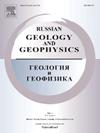Taseeva群(叶尼塞山脊)的古地磁:关于前寒武纪-显生宙边界的地磁场配置问题
IF 1
4区 地球科学
Q3 GEOSCIENCES, MULTIDISCIPLINARY
引用次数: 2
摘要
--我们报告了对安加拉河、塔塞瓦河和伊尔基涅瓦河下游三个典型剖面中叶尼塞山脊塔塞瓦群沉积岩的古地磁记录的详细研究结果。我们的研究结果证实,地磁场在前寒武纪-显生宙边界处于异常状态。众所周知,埃迪卡拉纪岩石总体上保留了几个不同的古地磁方向,这些方向不符合地心轴向偶极子模型。例如,西伯利亚剖面显示了两组同样有效的古极,这两组古极在地磁场的几何结构以及其中是否有任何分量对应于其偶极配置方面引发了许多争论。我们研究的古地磁记录是独特的,因为Chistyakovka和Moshakovka地层的岩石捕捉到了这两种成分,这是两种来源同时存在的事实证据。为了解释这些发现,我们提出了一个原始假设,其中广泛存在于岩石中并对应于马达加斯加古磁极群的双极分量与地心轴向偶极子场有关。与澳大利亚-南极极点组相对应的分布范围较小的单极分量反映了一个静止的异常源。由于Chistyakovka和Moshakovka地层积累期间可能处于最低水平的虚拟偶极矩的强度突然下降,记录该源成为可能。为双极分量计算的新古磁极——39.2°N,61.1°E——绘制在西伯利亚的视极漂移路径上,可以被认为是年龄~570 Ma的关键决定因素。本文章由计算机程序翻译,如有差异,请以英文原文为准。
Paleomagnetism of the Taseeva Group (Yenisei Ridge): on the Issue of the Geomagnetic Field Configuration at the Precambrian–Phanerozoic Boundary
—We report results of a detailed study of the paleomagnetic record in the sedimentary rocks of the Taseeva Group of the Yenisei Ridge in three typical sections in the lower courses of the Angara, Taseeva and Irkineeva rivers. Our results confirm that the geomagnetic field was in an anomalous state at the Precambrian–Phanerozoic boundary. It is well known that Ediacaran rocks in general have preserved several different paleomagnetic directions that do not conform to the geocentric axial dipole model. For example, Siberian sections display two equally valid groups of paleopoles that cause many debates over the geometry of the geomagnetic field and whether any of the components correspond to its dipole configuration. The paleomagnetic record we studied is unique in that the rocks of the Chistyakovka and Moshakovka formations have captured both these components, which is factual evidence of a synchronous existence of two sources. To explain these findings, we propose an original hypothesis in which the bipolar component that is widely present in the rocks and corresponds to the Madagascar group of paleomagnetic poles is associated to the field of the geocentric axial dipole. The less widespread monopolar component corresponding to the Australian–Antarctic group of poles is reflective of a stationary anomalous source. The recording of this source became possible due to the abrupt decrease in the strength of the virtual dipole moment that probably was at its lowest during the accumulation of the Chistyakovka and Moshakovka formations. The new paleomagnetic pole calculated for the bipolar component – 39.2°N, 61.1°E – plots on the apparent polar wander path for Siberia and can be considered a key determination for the age ~570 Ma.
求助全文
通过发布文献求助,成功后即可免费获取论文全文。
去求助
来源期刊

Russian Geology and Geophysics
地学-地球科学综合
CiteScore
2.00
自引率
18.20%
发文量
95
审稿时长
4-8 weeks
期刊介绍:
The journal publishes original reports of theoretical and methodological nature in the fields of geology, geophysics, and geochemistry, which contain data on composition and structure of the Earth''s crust and mantle, describes processes of formation and general regularities of commercial mineral occurrences, investigations on development and application of geological-geophysical methods for their revealing. As to works of regional nature, accelerated publication are available for original papers on a variety of problems of comparative geology taking into account specific character of Siberia, adjacent Asian countries and water areas. The journal will also publish reviews, critical articles, chronicle of the most important scientific events, and advertisements.
 求助内容:
求助内容: 应助结果提醒方式:
应助结果提醒方式:


